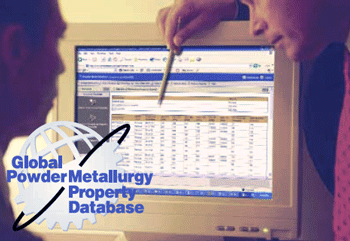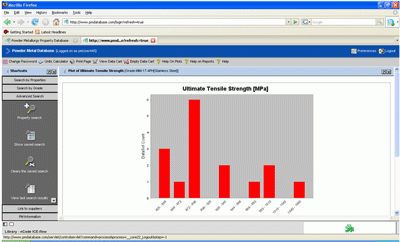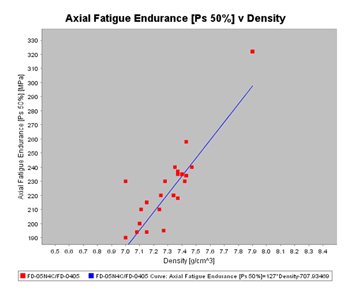‘Global Powder Metallurgy Property Database’ provides designers with easy access to sintered component data

The Global Powder Metallurgy Property Database is free-of-
charge and currently has 9000 registered users
The Global Powder Metallurgy Property Database is the result of a global collaboration between the three major regional trade associations: EPMA (Europe), MPIF (North America) and JPMA (Japan).
In assembling the GPMPD content, a broad range of mechanical, fatigue and physical property data was collected from the associations’ memberships and rigorously evaluated by regional accreditation committees. This data was then fed into an easily searchable on-line database format.
Access to the database is free-of-charge and currently has some 9000 registered users. The database’s primary targets are designers and material specifiers in end-user industries who may have no prior knowledge of PM.
Jonathan Wroe, EPMA Executive Director, told ipmd.net, “The EPMA sees great benefit in providing this important data to designers and engineers. Thanks to a collaboration across the PM industry we have developed a valuable online resource that clearly demonstrates the capabilities and opportunities provided by the PM process.”
On-going development
At the time of launch, the content of the database was restricted to data on low alloy ferrous and stainless steel PM structural part grades along with bronze and iron-based PM bearing grades. However, enhancement and extension of content and searching capability has been an ongoing process ever since.
The latest extension to capability, funded solely by EPMA member companies, involves making full SN Fatigue Curve data accessible to users. The initial content comprises over 130 SN Curve pages, covering a range of Fe-Cu-C grades and based on published information that has been analysed and collated by the group led by Professor Paul Beiss at the Technical University of Aachen, Germany. The collated SN curves cover a range of material processing conditions, density levels and a range of fatigue testing conditions.
During the past year work has continued to develop this key promotional agent for the PM industry. An agreement with Granta Design the materials data specialists based in Cambridge, UK, has resulted in them releasing a version of the database to their customer base in the automotive and aerospace industries.
Further enhancements to the GPMPD are also currently under discussion. Firstly, some strain-controlled fatigue data might be added, using a similar format to the SN Fatigue Curve pages. Secondly, the European PM HIP Group, a recently formed EPMA sectoral group, is actively assessing the feasibility of introducing a new section of the database containing data for Hot Isostatically Pressed (HIP) materials.
Using the database
The data included has been rigorously accredited and is therefore representative of the properties that can be achieved with good processing practice. However, the data is not intended to be a substitute for a subsequent full component development programme in collaboration with a parts manufacturer.
It is assumed that a user, unfamiliar with PM, would start from a required level of a property (or a combination of properties), based on previous experience in designing a similar component in other materials. Therefore, basic and advanced “Search by Property” options have been designed that allow searches against designated properties.
Such a search would result in a list of material grades that comply with the specified property requirements. If this list is sufficiently long, this could even be the end-point of the search; the user might then be sufficiently confident that PM is capable of “doing the job for them”.
The user may however want to go further. Specific grades of particular interest can be investigated by creating tabulated “grade reports” of all property types held in the database. These grade reports can be refined, by selecting narrower PM processing conditions.
Plots can then be created from a grade report of specific properties as a function of density (in the case of structural part or bearing materials) or of selected properties against one another. Using these plots, a user can make a preliminary definition of “preferred” grades/densities (and perhaps processing conditions).
For a selected grade, relevant data can be drawn down in an “FEA download file” that the designer can read directly from their FEA software package to allow a preliminary linear elastic finite element analysis to be carried out. The database structure can already directly generate FEA download files in formats compatible with MSC Nastran, HKS Abaqus and Ansys software. The critical material parameters in these download files are Density, Young’s modulus, Poisson’s ratio and Coefficient of thermal expansion.
The database’s content holds relationships allowing the direct calculation of the other three parameters on the basis of the specification of a grade designation and density level.
At any of the above stages, a user can go directly from relevant grade report(s) to a list of PM parts manufacturers, who have the capability to process the selected grade(s).
Metal Injection Moulding specific data
The MIM content of the database covers a range of stainless steels, low alloy steels, iron-nickel elemental mixes, tool steels, soft magnetic grades and non-ferrous grades (Ti and Ti-6Al-4V).
Although the basic structure and operation of the database remains similar to that for conventional PM structural part and bearing materials, certain changes were required to cope with the differing requirements for MIM materials. These changes first become apparent with the appearance of a new first selection page in all search options that allows the differentiation between a MIM-specific search and a Conventional PM search.
Search options then remain similar to the original structure, until the point where plots are created from individual grade reports. As MIM materials are always deliberately processed to achieve density levels within a few percent of full density, it was not considered appropriate to create plots of properties against density for a given MIM material. Instead, histograms, of the range of properties in the database content for the particular material, are presented.
As with the conventional PM materials, the automatic creation of FEA download files from grade reports is supported for all ferrous materials, including stainless steels.
A further option allows access to a tabulation of all SN Fatigue Curves held in the database. From this tabulation, the user can select a link for any material/condition of interest, which displays the relevant SN Curve as a pdf file that can be viewed on-line or downloaded. Links also exist from relevant grade report pages, which access tabulations restricted to SN Curve pages for that particular grade only.
www.epma.com
www.mpif.org
www.jpma.gr.jp
Visit www.pmdatabase.com to access the database
News | Articles | Market reviews | Search directory | Subscribe to e-newsletter
Published on www.ipmd.net
News, articles and a fully searchable directory for the powder metallurgy industry







